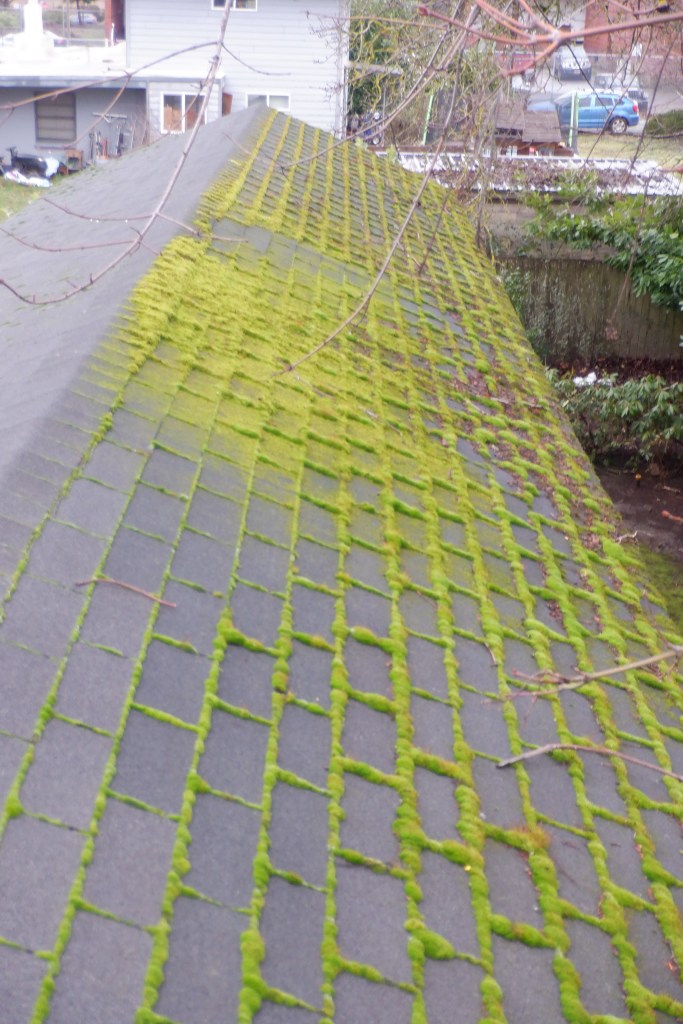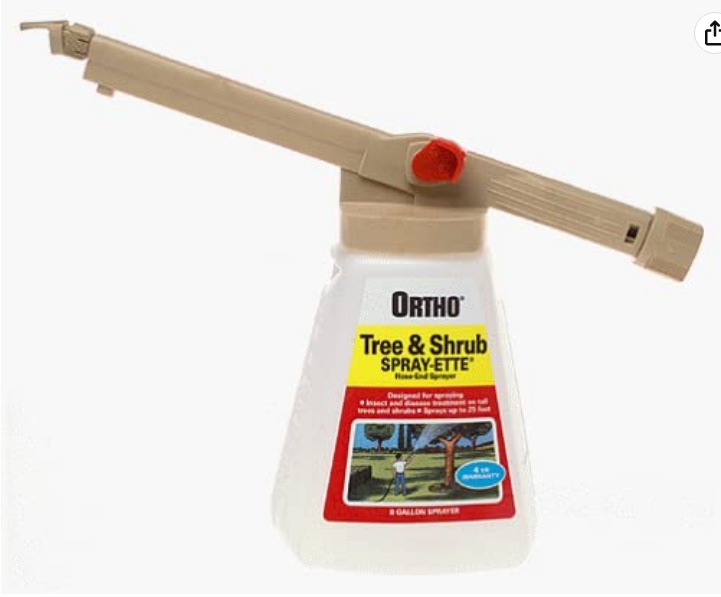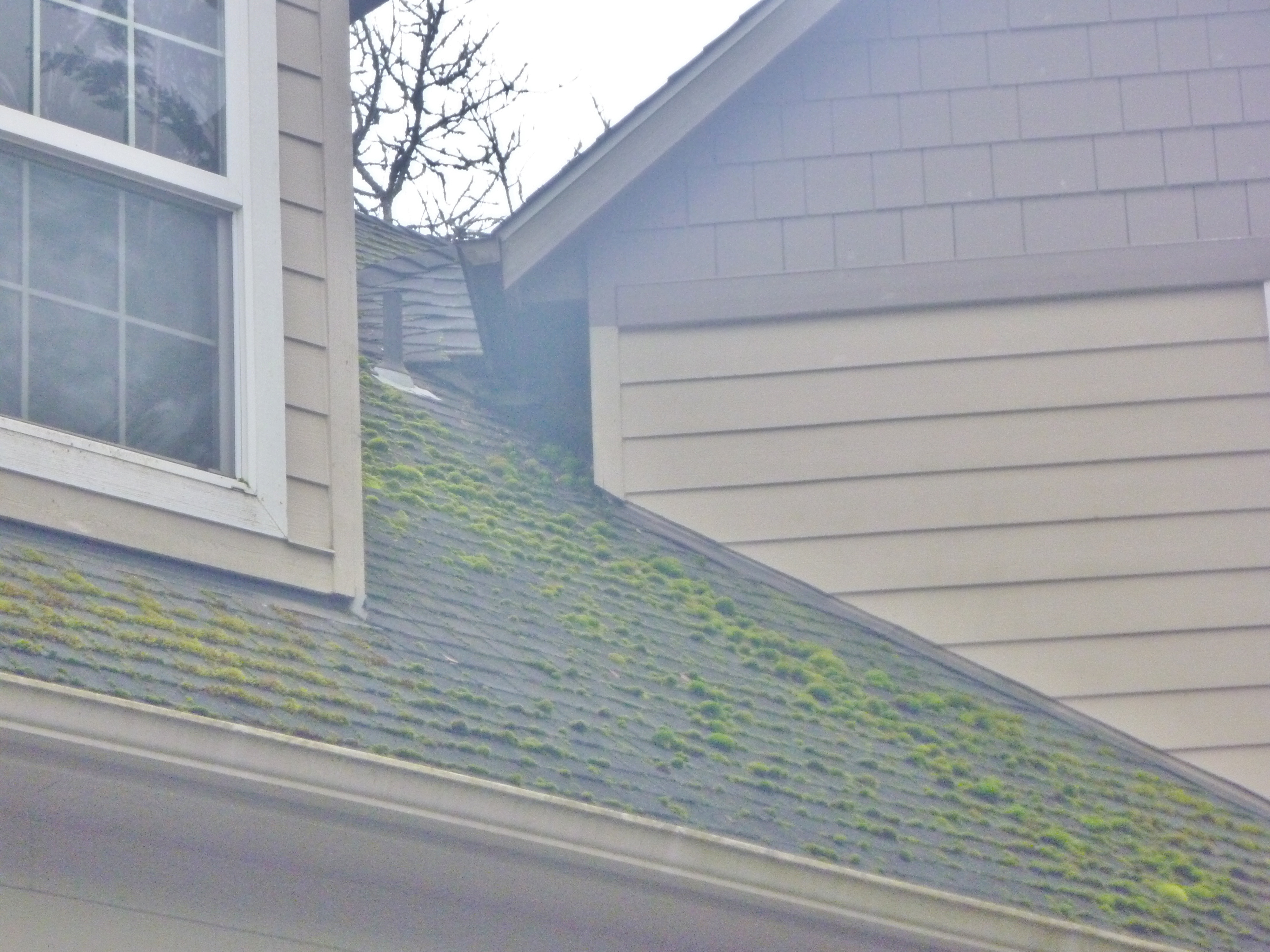
Moss is very common in this area. Moss and algae grow mostly in areas of low light and high moisture. Low light and high moisture pretty well describes most of the western northwest and the wintertime. Some of the most common ways to treat and maintain your roof are listed below.
One of the areas that moss is a concern on homes in this area our roofs. Depending on the roof’s exposure moss can grow most of the year. If sections of your home’s roof are shaded throughout the day and stay moist these are likely areas to grow moss.
Over time moss can damage your shingles if left un-checked. As the moss develops into a larger and larger colony more and more moisture is held against your roof. The colonies will also develop root-like systems that will dig into the surface fibers on your shingles. As the colonies grow larger, they can actually lift the edges of the shingles and delaminate the surface granules.
There are lots of ways to kill moss. Most of the good techniques involve some sort of the heavy metal application usually copper or zinc. Some really bad ideas involve laundry detergent and or power washers…
In general, the more trees you have around your house and/or the steeper your roof the more applications of moss killer you’ll need.
1. The best way to control moss is with an annual or biannual application of a powdered or liquid name brand moss killer designed for roofs. For steep roofs I have found the liquid anti-moss chemicals and a hose end attached shrub and tree sprayer to be a handy tool.


2. Another option for continuous moss control are some new shingles that are actually impregnated with copper granules. I have only seen the shingles used on several roofs and the major issue with these is the fact that the ridge shingles did not appear to be impregnated and still need to be treated for moss/algae growth.

3. Mechanically removing the moss is also an option. This option is really only for the very worst conditions. It involves a paint scraper, screwdriver, putty knife or something similar and trekking across your roof slope and very carefully removing the moss growth. This technique is very prone to damage of the asphalt composition shingles and should be used as a last resort.

4. Zinc or Copper Strips- These may be ok for preventing algae growth but moss looks at the little strips and laughs. You may have noticed some homes around town that have clear/clean sections of shingles under the metal roof vents. What is going on here is the zinc from the galvanized steel roof vents is leaching onto the roof surface and running down every time it rains. This has lead people to believe that sections of copper wire or small strips of zinc could be an effective way to kill moss. In the wet PNW this is not an effective technique. The difference is all about surface-area. The galvanized roof vents have a good amount of metal exposed and therefore a pretty good amount of zinc washes down the roof surface. Compare that surface to the 2″ wide strip of zinc and you can see there will be far less leaching occurring off the little zinc strips. The strips usually are effective for 2 to 3 feet down the slope. I have seen the strips added every 2 feet down an entire roof slope. This installation appeared to be effective, but it was weird looking and I have only seen that once on the top of a three-story apartment building.
5. Power washing, scraping with brooms, or laundry detergent. Unfortunately, I see the aftermath of these steps to control roof moss on far too many Salem area home inspections. If you are reading this post you probably have educated yourself enough to know that blasting or scraping the surface off of your asphalt composite roof is a bad idea.
-There may be some contractors who use power washers to clean roofs, but these individuals are licensed, bonded (and most importantly insured) and have the experience to know which nozzle to use and how far to hold it away from the roof surface. Even with this experience and expertise roof life is blasted away. It is probably the last 5-10 year of roof life, so you may not see issues for a while. Power washing should be strictly limited to the driveway and walkways surfaces around your home.
-Brooms and other mechanical abrasives are also techniques that should either be left on the ground or for qualified professional contractors. The removal of the surface granules on the asphalt shingle removes the ultraviolet resistance of the shingles and will cause premature failure of the system.
-Laundry detergent, although will kill moss on your roof, is full of degreasers. An asphalt based composite shingle is a petroleum-based grease compound. Do not put degreasers on your greasy roof! (Thanks Joe Ocilia for educating me on this fact!)

Do you have any evidence to back up the theory that laundry soap damages asphalt roofs? People have been doing this for decades and only recently have I heard that it is a problem.
Yes I do Don. I have seen large chunks deteriorate from the surface of comp shingles after laundry detergent was applied. Most of the time the soap doesn’t sit on the surface very long and the damage that can be noticed is subtle. If you accelerate the deterioration the surface of your 30-year roof by 4-5 years you usually won’t be able to notice this until the roofing is at the end of its life.